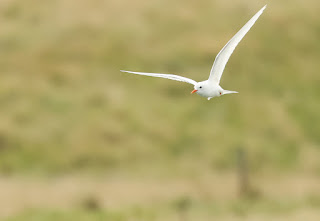Arctic Tern: Take a look at this stunner, lacking pigment within its feathers making it pure white this leucistic Arctic tern was a sight! It stood out like a beacon even from the otherside of the mere.
The bird has taken up residence at Hornsea Mere for a few weeks now, joining the increasing numbers of little gull feeding on the newly emerging lake fly.
When I arrived the bird was nowhere to be seen, not resting on the jetty or feeding over the water,, not a sign of it.
Local bider Nick Lawman was also searching and scanning the water for the bird.
Not before long I pointed it out as it was hawking close to the reeds on the far side of the mere, the bird also came over and rested on the jetty albeit for a very short time.
Chatting to Nick we decided to rent a rowboat and take the opportunity to get a little closer to both the tern and the little gulls.
The boat rental can be done card or cash at the cost of £5 each and is manned by two of the nicest blokes.
Little Gull: Hornsea Mere is famous for its little gull roots with thousands of birds attending at anyone time and many remaining throughout the day. There was still over 200 birds present while I was there mid morning.
Over the next few weeks, thousands of these small charismatic gulls make their way down the North Sea from their breeding grounds in Scandinavia and the Baltic.
So we headed out on to the open water, I rowed out not in a particularly straight line, slow and steady we made it over to the side where we last saw the tern.
Not long after we arrived we drifted into the shallows and had to use the ores to push ourselves back out onto the water.
The tern reappeared and put on a magnificent display as it flew up and down the front of the reeds before whizzing right past our boat and across the mere out of sight.
The little gulls were also busily feeding around our small boat. With a couple of smart looking juveniles and even a near full summer plumage adult sporting a near perfect back hood.
They were plucking flies from the top of the surface of the water, hawking right in front of us.
I didn't realise how difficult it would have been out on the boat, sure physically rowing the boat was difficult and tricky but that I did expect. But the wind was affecting the water and the boat was bobbing up and down which made it particularly difficult to hold the camera steady!
Nick rowed back, and in all fairness he did a much better job of it then I did. Faster, straighter and he didn't find it all that difficult to turn the boat.
I have to say I really enjoyed this mini-adventure, OK the photography opportunities weren't great and it was much more difficult than either of us originally anticipated, but we did get closer to the tern and the gulls.
Big thanks again to Nick whos rowing silks were just the ticket and allowed me to get some extra snaps of the gulls on the water.
Arctic Tern: If you chose not rent a boat then it's worth waiting alongside the jetties as the gulls rest on here throughout the day and the tern can make an appearance here too.



































